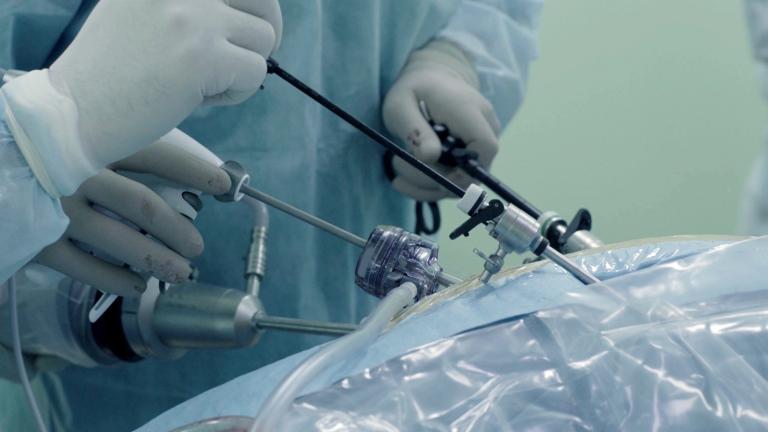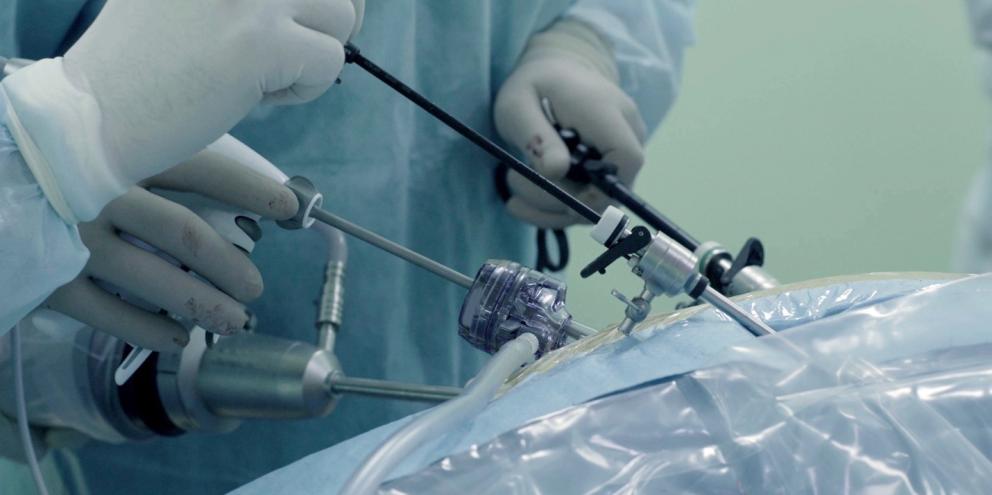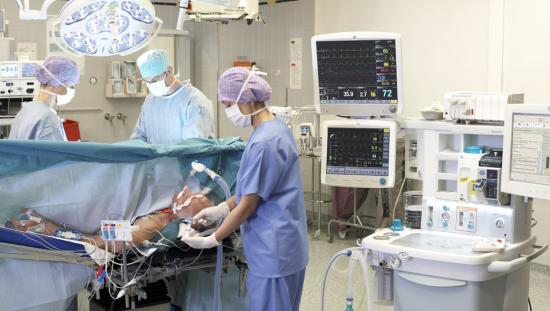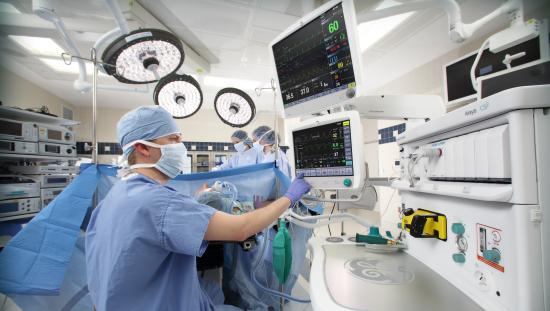
In order to reduce these risks, safe ventilation strategies are needed. While the most common ventilation mode used in anesthesia is volume-controlled ventilation (VCV), this option may predispose patients to barotrauma. Because of this specific issue, pressure-controlled ventilation (PCV) mode was introduced as an alternative mode in laparoscopic surgeries, an option that offered a reduction in barotrauma, yet also increased the risk of hypo- and hyperventilation.
That is why more studies are focusing on the benefits of pressure-controlled volume guaranteed ventilation (PCV-VG), which incorporates the benefits of both VCV and PCV, while reducing the negative consequences associated with the two modes.
In this article, we’ll discuss the unique challenges laparoscopic surgery presents, as well as the merits of PCV-VG compared to VCV. We’ll also take a look at the current state of research that backs PCV-VG as the superior ventilation strategy for laparoscopic procedures.
Patient Positioning Results in Safety Concerns
Trendelenburg position is routinely requested by surgeons during laparoscopic procedures to facilitate the exposure of the pelvis and the lower abdomen. However, this clinical technique, wherein the body is supine and tilted so that the head is lower than the body and the legs, can lead to serious physiologic consequences, including significant negative cardiorespiratory effects.
That tilt results in the cephalad movement of the diaphragm by abdominal contents and pneumoperitoneum, leading to increased peak airway pressure and a decrease in lung compliance by 25% – 40%, as well as a marked increase in the airway pressure1.
Additional issues include2:
- A decrease in lung volumes
- Increased mean arterial pressure
- CO2 absorption associated with acidosis
Together, these changes can result in a wide range of cardiopulmonary distress, especially in older patients, or those who are morbidly obese or have chronic lung disease3,4.
Comparing Ventilation Strategies
Because the technique of laparoscopy involves significant cardiorespiratory adverse effects, it must be balanced with safe ventilator management to reduce patient safety concerns. However, there has been a debate concerning which strategy is best leveraged to accomplish this goal.
VCV has been the ventilation mode of choice in the surgical arena. Its constant flow pattern delivers a preset tidal volume in a preset inspiratory time. However, while VCV is capable of guaranteeing the target minute ventilation, it comes with a serious risk.
The use of VCV during a laparoscopic procedure with the patient in the Trendelenburg position may result in a higher peak inspiratory pressure (PIP) and can lead to1:
- Shear stress injury
- Barotrauma
- Volutrauma to the alveoli
- Micro-atelectasis
- Inflammatory mediator release characteristic of ventilator-associated lung injury
As an answer to these risks, PCV mode, which delivers tidal volume using preset pressure and inspiratory time at a decelerating flow, became an alternative to VCV. While PCV does work to attain tidal volume at lower peak inspiratory pressures, this benefit is achieved at an expense. Because PCV results in changing lung compliance, the tidal volume varies, and the risk of hypoventilation and hyperventilation increases1.
With the failure of both VCV and PCV to offer benefits, while reducing patient risk, a new mode, PCV-VG was introduced, using a decelerating flow pattern and constant pressure.
With PCV-VG, ventilator parameters are automatically adjusted with each breath, calculating lung compliance and establishing the lowest possible pressure required to deliver the target tidal volume. This means that PCV-VG incorporates the advantages of both VCV and PCV, preserving the target minute ventilation, while reducing the risk of sheer stress and barotrauma.
The Case for PCV-VG in Laparoscopic Procedures
Multiple studies have now proven the superiority of PCV-VG in laparoscopic surgery.
Toker et al. studied 104 patients undergoing gynecologic laparoscopic surgery in the Trendelenburg position finding that, “The PCV-VG mode of ventilation limited peak inspiratory pressure, decreased the driving pressure and increased the dynamic compliance compared to VCV in obese patients3.”
A research article, published in BMC Anesthesiology, by Wang et al., randomly assigned elderly patients undergoing laparoscopic surgery to receive VCV or PCV-VG. Their results showed that there were significant differences in respiratory and hemodynamic variables between groups and concluded that, “In elderly patients who underwent laparoscopic surgery using an LMA, PCV-VG was superior to VCV in its ability to provide ventilation with lower peak inspiratory pressure and greater dynamic compliance4.”
Research from Apoorwa Kothari, Deepa Baskaran from the Department of Anaesthesia and Critical Care, St. John’s Medical College Hospital, India, once again compared the effects of VCV to PCV-VG, this time in 75 patients undergoing laparoscopic cholecystectomy1. Their findings showed that PCV-VG resulted in lower peak airway pressures than VCV, better preserved compliance and resulted in a lower arterial to end-tidal carbon dioxide gradient. The study authors concluded that pressure mediated modes are superior to VCV in providing adequate oxygenation at lower peak inspiratory pressures.
These results backed up the work of Boules, Ghobria and Song et al., who found that PIP was significantly lower in PCV-VG compared to VCV in all stages of the study1. Additionally, their research indicates that PCV-VG provided lower airway pressures.
Finally, in a study of 40 patients who underwent elective laparoscopic surgery in Trendelenburg position, by Osama et al., once again concluded that “PCV-VG was superior to VCV in its ability to provide ventilation with lower peak inspiratory pressure and greater dynamic compliance2.”
Summary
- Safe ventilation is a challenge in laparoscopic surgery due to insufflation of the peritoneum and patient positioning.
- High inflating pressures during mechanical ventilation predispose the patient to the development of barotrauma.
- Although VCV has been the mode of choice in anesthesia to guarantee the target minute ventilation, this strategy results in higher PIP, increasing incidence of barotrauma.
- PCV-VG is an innovative mode of ventilation that uses consistent tidal volume in a decelerating flow, without increasing airway pressures.
- PCV-VG offers the benefits of both VCV and PCV, while reducing the incidence of barotrauma, making it a standard mode of choice in surgeries involving changes in respiratory dynamics.
References
1. Kothari, Apoorwa, Baskaran, Deepa. “Pressure‑controlled Volume Guaranteed Mode Improves Respiratory Dynamics during Laparoscopic Cholecystectomy: A Comparison with Conventional Modes.” Anesthesia: Essays and Researches Vol. 12, Issue 1 (2017): Pages 206-212.
2. Assad, Osama MD et al. “Comparison of volume-controlled ventilation and pressure-controlled ventilation volume guaranteed during laparoscopic surgery in Trendelenburg position.” Journal of Clinical Anesthesia Vol. 34 (2016): Pages 55-61.
3. Toker, Melike et al. “Comparison of pressure-controlled volume-guaranteed ventilation and volume-controlled ventilation in obese patients during gynecologic laparoscopic surgery in the Trendelenburg position.” Revista Brasileira De Anestesiologia Vol. 69, Issue 6 (2019): Pages 553-560.
4. Wang, Ping et al. “Use of volume controlled vs. pressure controlled volume guaranteed ventilation in elderly patients undergoing laparoscopic surgery with laryngeal mask airway.” BMC Anesthesiology Vol. 21, Issue 69.
© GE, 2022 – All rights reserved
GE and the GE Monogram are trademarks of GE. Reproduction in any form is forbidden without prior written permission from GE. Nothing in this material should be used to diagnose or treat any disease or condition. Readers must consult a healthcare professional. JB18752XX












